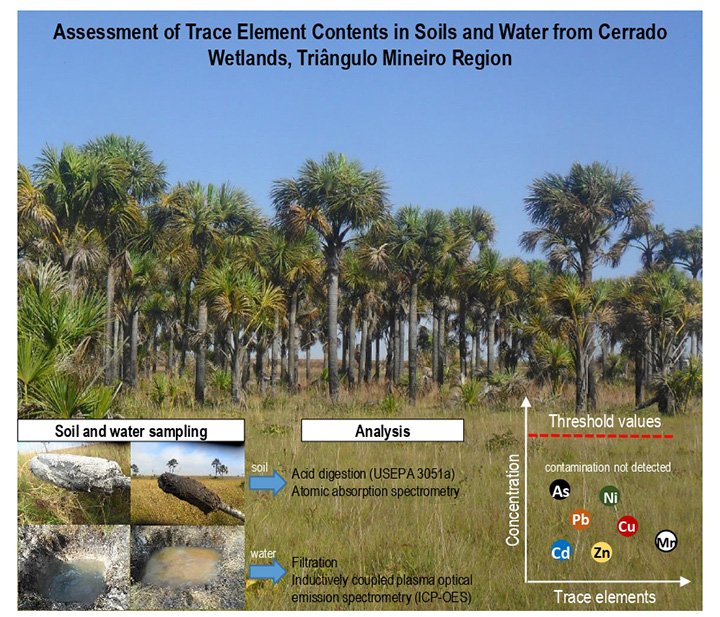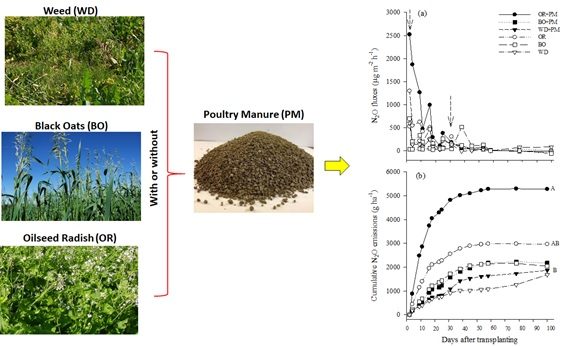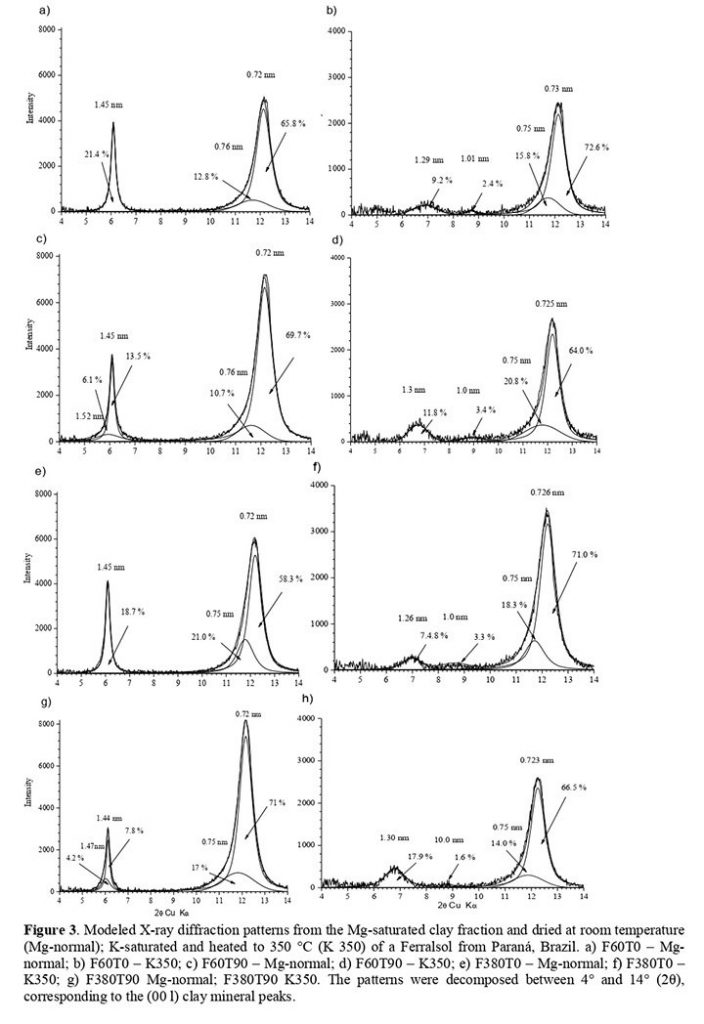Decomposition and Nutrient Release of Cover Crops in Mango Cultivation in Brazilian Semi-Arid Region
24/Apr/2019
ABSTRACT Knowledge of the decomposition dynamics of aboveground phytomass and its release of nutrients in mixtures of cover crops as well as the impact on the soil tillage system is fundamental for the sustainable management of agroecosystems. This work aimed to evaluate whether soil tillage and the choice of cover crops cultivated in the interrows can be technological strategies to increase dry biomass production, increase the capacity to add carbon, and improve macronutrient cycling in a mango ( Mangifera indica […]
Assessment of Trace Element Contents in Soils and Water from Cerrado Wetlands, Triângulo Mineiro Region
24/Apr/2019
ABSTRACT In the Brazilian Cerrado biome, there are wetlands locally known as “Veredas”, which are swampy plains between hills and rivers. Since the 1970’s, the Cerrado biome has been gradually converted to livestock, crop, or forestry production. Until now, very few studies were conducted to evaluate the baseline contents of trace elements in Cerrado wetland soils. Due to their position in the landscape (bottom lands), the wetlands are potentially susceptible to contamination by runoff and/or leaching from surrounding areas at […]
Nitrous Oxide Emissions in No-Tillage Onion ( Allium cepa L.) Crops Are Increased by Oilseed Radish Cover Crop and Poultry Manure Application
10/Apr/2019
ABSTRATO O uso de plantas de cobertura e de esterco de galinha (PM) é uma alternativa para reduzir o uso de insumos sintéticos e pode contribuir para o ciclo de nutrientes em cebolas ( Allium cepa L.) cultivadas em sistema plantio direto. No entanto, esta prática de gestão pode contribuir para um aumento das emissões de N 2 O para a atmosfera. Os objetivos deste estudo foram avaliar o efeito imediato sobre as emissões de N 2 O da adição […]
Does Ferralsol Clay Mineralogy Maintain Potassium Long-Term Supply to Plants?
10/Apr/2019
ABSTRACT Ferralsols ( Latossolos ) should contain few or no 2:1 clay minerals and have low potassium (K) contents, and consequently low levels of non-exchangeable K forms are expected. The aim of this study was to evaluate how the clay mineralogy of a Ferralsol affects the soil K dynamics in response to K fertilization during cropping and whether the clay mineralogy was altered due to successive crops and K fertilization. A tropical Brazilian Ferralsol under field conditions was sampled (0.00-0.20 […]
Optimal Simulation of the Land-Use Structure Based on the Local Ecological Environment: the Case of Huanghua City in Hebei Province, China
10/Apr/2019
ABSTRACT The overuse of land has resulted in a sharp decline in ecological functions, affecting the environment as it relates to the existence and sustainable development of the whole biosphere. This work aims to evaluate the ecological and economic efficiencies of the land-use structure. A simulation model, CLUE-S (Conversion of Land-Use and its Effects at Small Region Extent), and an integrated model based on the MOP (Multi-Objective Program) and CLUE-S were applied to assess the suitability of unutilized lands in […]
Timing and Splitting of Nitrogen Side-Dress Fertilization of Early Corn Hybrids for High Grain Yield
08/Mar/2019
ABSTRACT Currently, most nitrogen fertilizer is side-dressed when corn is in the four (V4) to eight (V8) expanded leaf stage. However, recent studies have shown that modern hybrids take up high amounts of nitrogen during grain filling. This indicates that a late nitrogen fertilization, at the time of crop flowering, may be important to optimize corn agronomic performance. This study aimed to evaluate the effect of the timing and splitting of nitrogen side-dress application on the agronomic performance of early […]
Physical, Chemical, and Microbiological Properties of Soil under Different Plant Covers in the Seridó Desertification Region in the Brazilian Semiarid
08/Mar/2019
ABSTRACT The Seridó Desertification Region is a result of inadequate management of the native Caatinga vegetation, which generated degraded areas with little or no capacity for plant production. The area has experienced a succession of different land uses, but little is known about the impact of these changes. The present study tested the hypothesis that the intense degradation of the Caatinga drastically decreased vegetal biomass production, which favored direct soil exposure and resulted in a lower abundance and diversity of […]
Do Aggregate Size Classes of the Subsurface Soil Horizon Have Different Chemical/Mineralogical Properties?
06/Feb/2019
ABSTRACT Variations in chemical and mineralogical properties of a soil can occur at short vertical and horizontal distances. The objective of the present study was to evaluate the chemical and mineralogical soil properties of different aggregate classes from young (Ustrochrept) and highly weathered (Acrustox) soils from the state of Paraná, Brazil. Undisturbed blocks (0.20 ×0.20 ×0.20 m) of soils were separated into aggregate classes: Acrustox – 8.0-4.0 mm; 4-2 mm; 2.0-0.5 mm; 0.5-0.2 mm; and <0.2 mm; and Ustrochrept – […]
Crop Yield Responses to Sulfur Fertilization in Brazilian No-Till Soils: a Systematic Review
06/Feb/2019
ABSTRACT Sulfur (S) fertilization recommendations for grain crops in Brazil were formerly established from studies on crops with a low yield potential grown on soils under conventional tillage (CT). However, the subsequent adoption of no-tillage (NT) altered S dynamics in the soil, making it necessary to carefully evaluate the applicability of these S fertilizer recommendations. In addition, the emergence of modern high-yield-potential genotypes, the successive application of concentrated low-sulfur fertilizers, and reduction in S atmospheric deposition have raised the likelihood […]
Potassium Fertilization of Eucalyptus in an Entisol in Low-Elevation Cerrado
06/Feb/2019
ABSTRACT Potassium (K) is one of the most highly accumulating nutrients in Eucalyptus and, consequently, is heavily exported by the harvesting of wood. Moreover, its availability in the soil in most Brazilian plantation areas is very low, especially in the regions of the Cerrado biome, which has soils with low natural fertility and marked water deficits, implying a lack of nutrient supply and, consequently, a less efficient water use. Our objective was to evaluate the effects of K fertilization on […]



